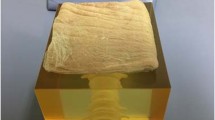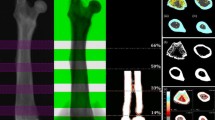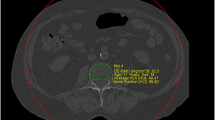Abstract
The European Spine Phantom (ESP) has recently been developed as a universal standard for instruments measuring bone density. The ESP is composed of three semi-anthropomorphic hydroxyapatite vertebrae of varying densities surrounded by soft tissue equivalent plastic designed to resemble human bone and soft tissue when scanned on bone densitometers. In multi-centre studies it is particularly important to verify that each participating bone densitometer is performing in a stable and linear fashion. The aim of this study was to evaluate the ESP within the context of a multi-centre clinical trial. Eighteen centres in the UK and Canada with dual-energy X-ray absorptiometry (DXA) instruments (Lunar DPX, DPX-alpha and DPX-L) participated in the study. The ESP was scanned 10 times on each instrument without repositioning using standardized protocols. The precision of the bone mineral density (BMD) measurements (L1–3) expressed as a coefficient of variation ranged from 0.4% to 1.1% (mean 0.7%). The mean BMD of each instrument was expressed as a percentage difference from the overall mean and ranged from −1.33% to 1.33%. Linear regression analysis showed that all instruments behaved in a linear fashion across the range of densities with correlation coefficients all ≥0.999 and standard errors of the estimate <1.5% of the mean BMD ESP value. The data from this study demonstrate that the ESP is a useful phantom for assessing the linearity, stability and differences between DXA instruments from one manufacturer.
Similar content being viewed by others
References
Gluer CC, Faulkner KG, Estilo MJ, et al. Quality assurance for bone densitometry research studies: concept and impact. Osteoporos Int 1993;3:227–35.
Faulkner KG, McClung MR. Quality control of DXA instruments in multi-centre clinical trials. Osteoporos Int 1995;5:218–27.
Orwoll ES, Oviatt SK, and the Narfarelin Bone Study Group. Longitudinal precision of dual energy x-ray absorptiometry in a multi-centre study. J Bone Miner Res 1991;6:191–7.
Slosman DO, Meunier PJ, Delmas PD, et al. The pivotal role of cross-calibration and quality control in an international clinical trial of the strontium salt S-12911 involving multiple DXA brands. Osteoporos Int 1996;6(Suppl 1):168.
Blake GM, Tong CM, Fogelman I. Intersite comparison of the QDR-1000 dual energy x-ray bone densitometer. Br J Radiol 1991;64:440–6.
Rencken ML, Murano R, Drinkwater BL, et al. In vitro comparability of dual energy x-ray absorptiometry (DEXA) densitometers. Calcif Tissue Int 1991;48:245–8.
Gaither KW, Faulkner KG, Ostrem EC, et al. Variations in calibration among like-manufacturer DXA systems. J Bone Miner Res 1996;11(Suppl 1):S119.
Kalender WA. A phantom for standardization and quality control in spinal bone density measurements by QCT and DXA: design considerations and specifications. Med Phys 1992;19:583–6.
Pearson J, Dequeker J, Henley M, et al. European semi-anthropomorphic spine phantom for the calibration of bone densitometers: assessment of precision, stability and accuracy. Osteoporos Int 1995;5:174–84.
Dequeker J, Pearson J, Reeve J, et al. Dual x-ray absorptiometry: cross-calibration and normative reference ranges for the spine. Results of a European Community Concerted Action. Bone 1995:17:247–54.
Genant HK, Grampp S, Gluer CC, et al. Universal standardization for dual energy X-ray absorptiometry: patient and cross-calibration results. J Bone Miner Res 1994;9:1503–14.
Kalender WA, Felsenberg D, Genant HK, et al. The European Spine Phantom: a tool for standardization and quality control in spinal bone mineral measurements by DXA and QCT. Eur J Radiol 1995;20:83–92.
Mazess RB, Trempe JA, Bisek JP, et al. Calibration of dual-energy X-ray absorptiometry for bone density. J Bone Miner Res 1991;6:799–806.
Tothill P. Cross calibration of DXA scanners for spine measurements [letter]. Osteoporos Int 1995;5:410–11.
Nord RH. Performance of the European spine phantom: an evaluation from published data. Presented at the 11th International Bone Densitometry Workshop, Gleneden Beach, Oregon, USA, 1995:63.
Blake GM. Replacing DXA scanners: cross-calibration with phantoms may be misleading. Calcif Tissue Int 1996;59:1–5.
Vilstrup L, Mollgaard A, Haubro AM, et al. Quality assurance of multi-centre clinical trials including measurement of bone mass, precision and accuracy. J Bone Miner Res 1994;9(Suppl 1):S333.
Author information
Authors and Affiliations
Rights and permissions
About this article
Cite this article
Lees, B., Garland, S.W., Walton, C. et al. Evaluation of the European spine phantom in a multi-centre clinical trial. Osteoporosis Int 7, 570–574 (1997). https://doi.org/10.1007/BF02652564
Received:
Accepted:
Issue Date:
DOI: https://doi.org/10.1007/BF02652564




